|
T h e M y t h
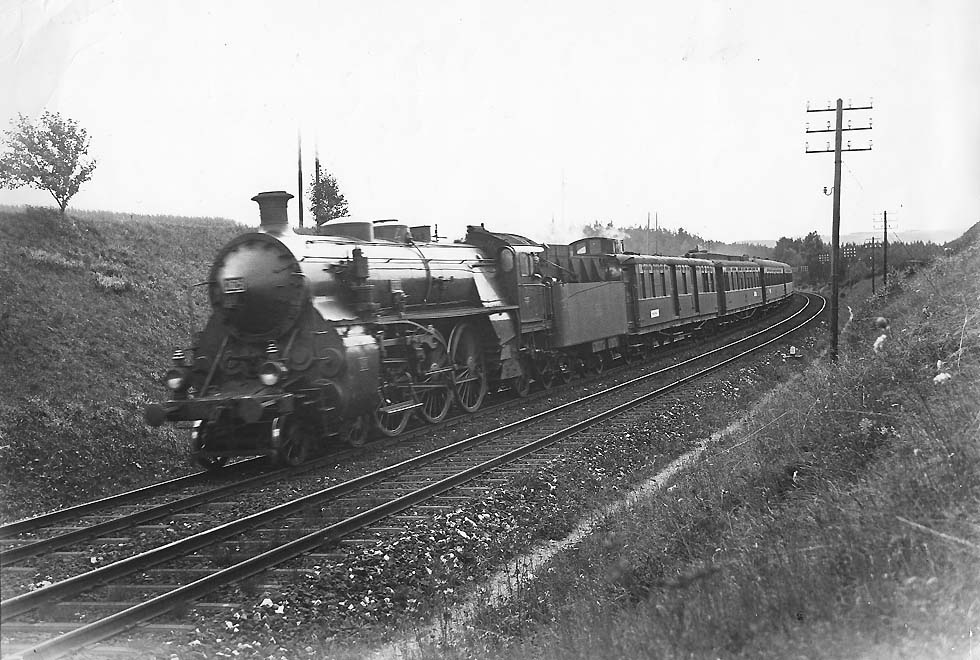
Paris-Carlsbad-Express, a section of the Orient-Express, DR Pacific 18 442, Bavarian class S3/6, CIWL van and diner Stuttgart - Prague and the rare wooden S type sleepers from Paris, Calais and Oostende, near Schnabelwaid, Bavaria, 1927 (Ernst Koeditz)
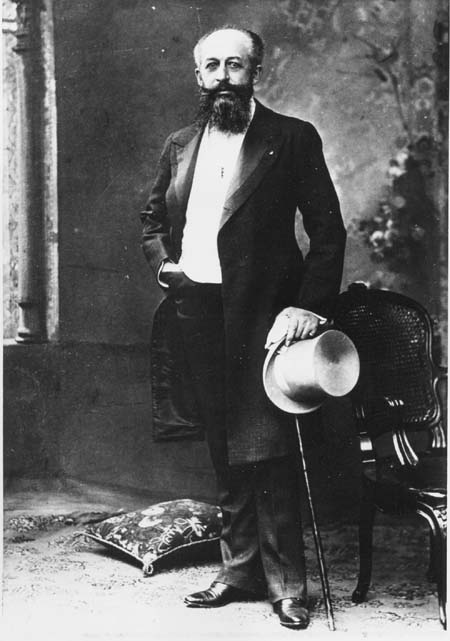
Orient-Express dining-car c.1883 (contemporary press)
|
" On rencontrait dans les couloirs de l'Express une race qui disparaissait avec Abd ul-Hamid, vieux seigneurs osmanlis ou ottomans (mortellement offenses si vous les appeliez des Turcs), pachas a fez, vetus de la longue redingote nommee stambouline ; ils enfermaient leurs epouses voilees dans le compartiment, ou le controleur n'avait pas acces ; des nuees d'agents secrets les entouraient ; ils avaient amene avec eux leur cafedji bachis, qui leur preparaient le cafe, tant ils redoutaient, meme en voyage, quelque " mauvais cafe " envoye par le nouveau gouvernement. "
Paul Morand
"Le voyage"
|
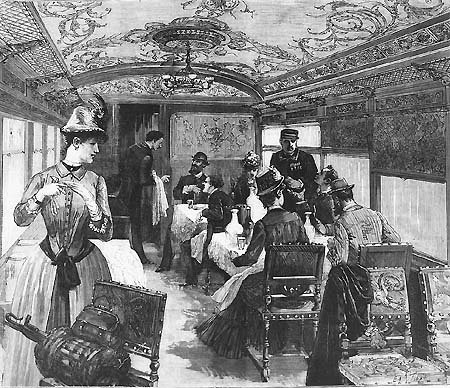
Orient-Express dining-car c.1883 (contemporary press)
|
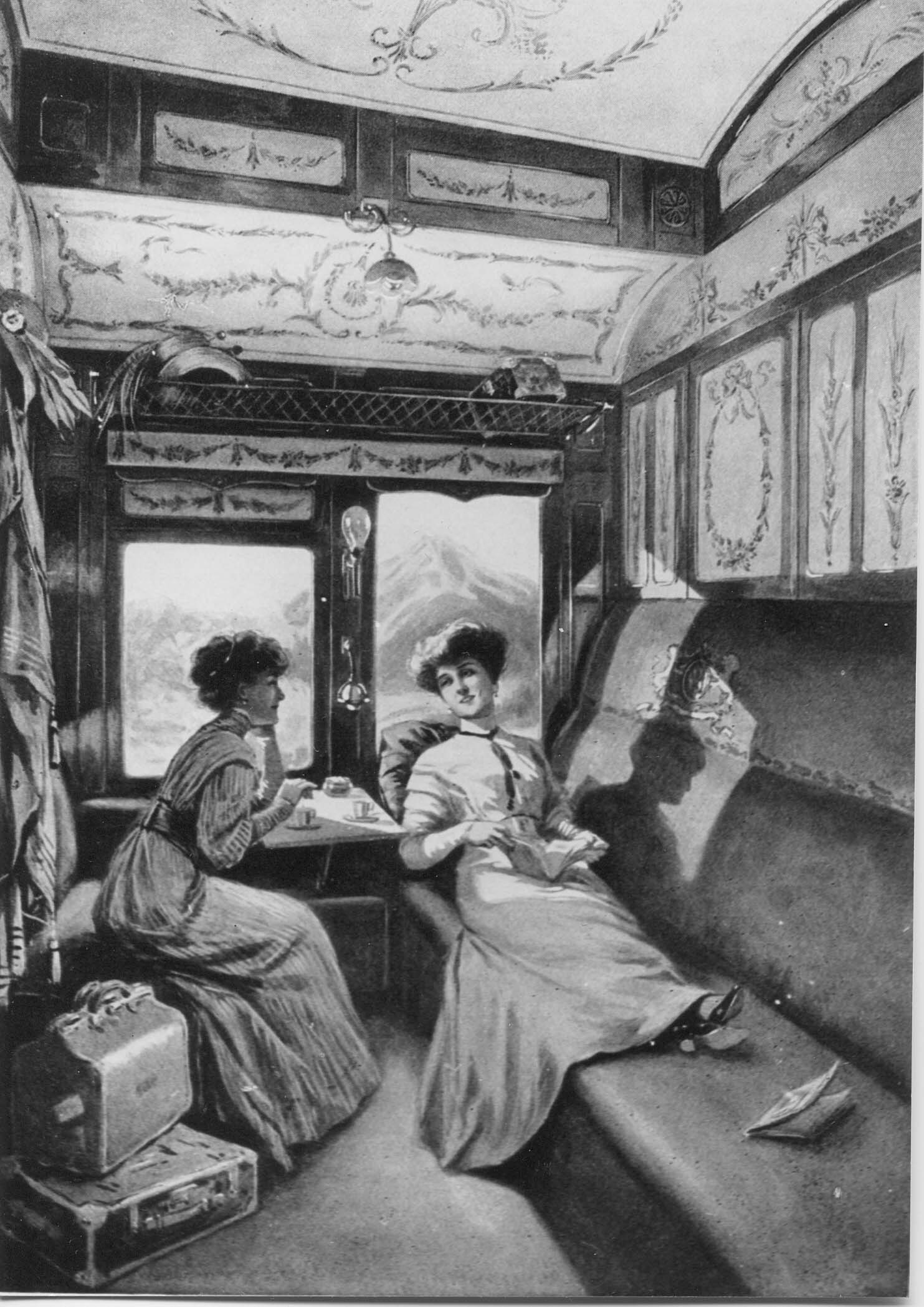
Wagon-Lits before WWI (coll. WS)
|
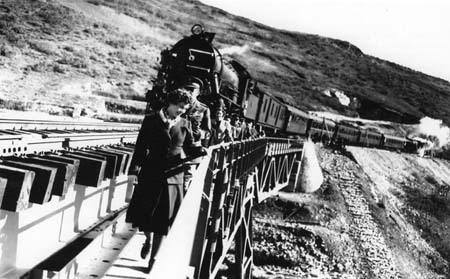
The Queen of Greece opening a bridge after civil war (contemporary press, coll. WS)
|
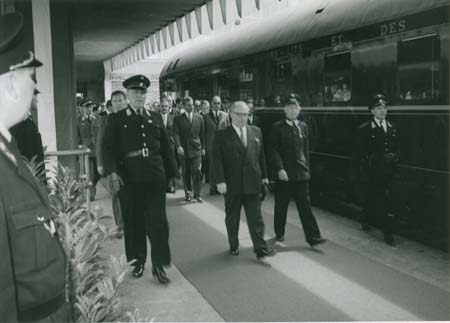
Departure of the Shah of Persia at Vienna in 1970 (OeBB Bildstelle)
|
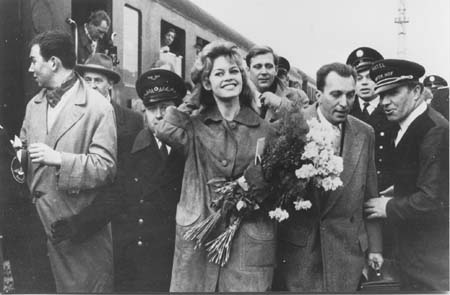
Brigitte Bardot arriving with the Orient-Express at Munich (DB-Museum Nurnberg)
|

‘Komfort-Wagen’ of OeBB, added at Munich to ‘Mozart’ Paris – Vienna, 1971 (WS)
|
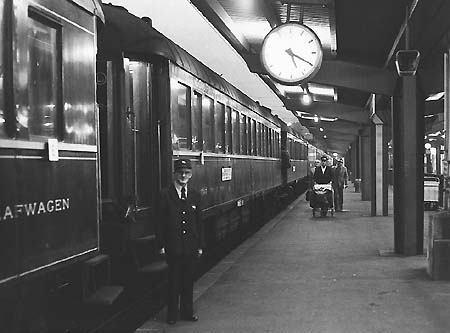
Nostalgie Istanbul Orient Express Stuttgart - Istanbul, Salzburg,
Oct.10, 1977 (WS)
|
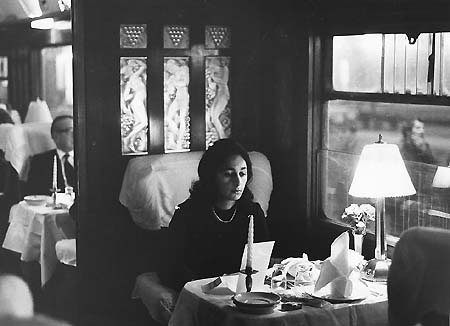
Nostalgie Istanbul Orient Express Pullman, Gala-Diner (WS)
|
"Orient-Express" - that means the most famous label being of value to railway entrepreneurs, novel writers, movie makers and attorneys fighting for it, while the names of the other Grand European Expresses are forgotten. The Orient-Express however was not always a certain train, it was a multitude of very different expresses.
The original Orient-Express was the first express crossing half a dozen countries and the first train connecting Europe with Istanbul, then known as Constantinople. And it was Europe's first de-Luxe of an all-sleeper train network created by the Belgian Georges Nagelmackers, the European visionary, and his Compagnie Internationale des Wagons-Lits et des Grands Express Europeens. It resulted from the imperialists' desire for a connection with the Osman empire, which they wanted to share up between themselves. As a private enterprise, the Orient-Express must have been a de-Luxe with high fares - rendered possible only by the underpaid working class of that epoch. A test run Paris - Vienna was undertaken in 1882 by the Train Eclair, in German "Blitzzug". In June 1883 started the scheduled services from Paris to Giurgiu in Romania, where the passengers had to change to a Danube ferry, then to a simple train Ruse - Varna and finally to an Austrian Lloyd steamer. The de-Luxe in France was called Express d' Orient, in Germany it was known also as Orient-Blitzzug, but soon it became the famous Orient-Express. Every historic detail has been written down in books and railway magazines and the tabloids continuously are inventing crazy Orient Express stories, from Tsar Ferdinand to King Leopold, from Josephine Baker to King Carol…
Most stories are not true, and the classic Orient-Express has not been as luxurious as suggested. Like the other European expresses its cabins had not even been equipped with en-suite toilets. And the sumptuous "Pullman" day saloons of the twenties, now being the highlights of the nostalgic trains, by some reports praised as the original Orient-Express cars, generally did not run on old Orient Expresses! But the ancient Wagons-Lits, the wooden ones, had its "cachet de yacht de-Luxe" and the all-steel ones, dark blue, nearly black from smoke, showed the majesty of old battleships, guarded by French officers (the Wagons-Lits conductors' look). Sometimes even the kings attached their own royal saloons to an Orient-Express.
The solid menus aboard the de-Luxe trains, always strictly French, were superb and even after World War II the Wagons-Lits diners offered "haute cuisine". The Nostalgic Istanbul Orient Express revived the tradition:
Consommé Xavier
Salmon en Bellevue
Cuissot de Veau "Ecarlate"
Asperges a l' italienne
Souffle " Alaska "
Corbeille de Fruits
This had been a menue by CIWL maestro Falciola.
After lunch or dinner the guests leaved immediately and went silently to their cabins, that's reported at least from the time between the wars, when mostly officials were the few passengers of the de-Luxe trains. No much stuff for "sleeping stories"…
Cosmopolitan were the grand expresses still at the end of the forties and in the fifties, initially with the de-Luxe label, but now including a multitude of coaches from many countries. Though the Orient-Express at that time was already a modest train for everybody, Brigitte Bardod and ex-Empress Soraya used it when they traveled from Paris to Munich. During the own boyhood, the Alberg-Orient-Express in neighbouring Tyrol was the sensation: sixteen or more cars, Wagons-Lits, French, Swiss, Austrian coaches, some rare ones from Czechia or Hungary, the Art-deco type from Northern France and, never seen before, a blue/white Pullman of CIWL. East of Linz it was still steam-hauled, by the huge black 214s, with its malicious staccato and blowing safety-valves thundering through the small stations, roaring into the Eastern night, towards Vienna, Budapest, Bucharest.
What fantastic locomotives hauled the Orient-Expresses! During the first quarter of the century there were the beautiful Maffei S3/6 and the unique S2/6 in Royal Bavaria, designed by Anton Hammel, Leppla and von Biber. A Niagara was their dream, never really designed and therefore there are no authentical drawings (as the competent Bavarian locomotive historian J.B. Krowawitter had confirmed). Or let's think of Goeldsdorf's 310, a 2-6-4 in old Austria, the Hungarian 203 class Atlantic, the sole Pacific number 21, built in Belgium for the Bulgaria of Tzar Ferdinand, who was an enthusiastic locomotive driver… or the huge Mountains of the SNCF, the 241A ex-Est on the Orient and the 241P on the Arlberg-Orient-Express after World War II, the Czech Mountains 498.0 and 498.1 double-heading the Balt-Orient (which in Hungary was hauled by two 4-4-4 tank engines, streamlined in German 05 style), or the Austrain 2-8-4 type 214 (or 12), the similar Romanian 142, three big engines, a 142 or 151 and 150 thundering uphill the Carpathian mountains (the Arberg-Orient-Express was hauled by the DF241, a huge pre-war diesel), or the nice Italian Pacifics 691 and the strange Franco-Crosti 683 with the Simplon-Orient-Express, or the Greek Mi alpha, an immense Italian-built 2-10-2, filling the narrow tunnels with its nearly 200 tons of iron and its black oil smoke, while storming southward through Greece with the Simplon-Orient and the Tauern-Express. There were no projects, but obviously dreams, even of a Niagara for the line facing Mount Olympus and the Parnass.
Gone have the days of steam and of the grand expresses. No regular trains are connecting France with Hungary and Germany with Istanbul, not a single train from Western Europe has its arrival at Athens. Mikis Theodorakis' sentimental song "The train leaves at eight" is only a remembrance of the past. Eight o'clock in the evening was the departure time of the migrant workers' trains from Athens to "Europe", as the Greek used to say, the Direct-Orient, still known as the "Simplon", then the notorious Hellas-Express. The myth survived exclusively by the nostalgic de-Luxe specials.
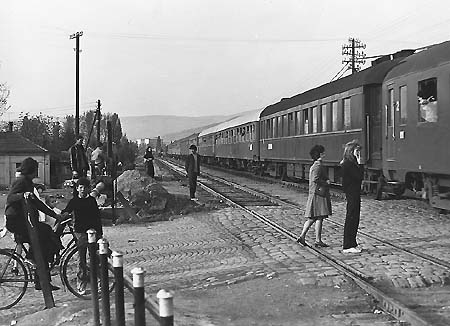
Athenes-Express/ Direct-Orient Athens - Paris, Nish, Serbia, April 1971 (WS)
|
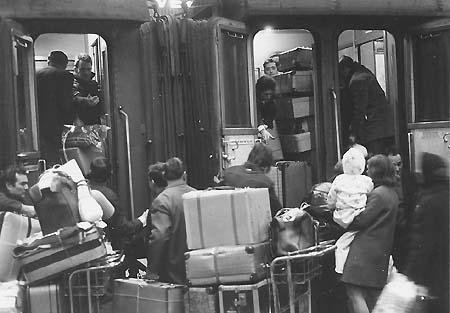
Migrant workers' special Germany - Greece, Munich 1971 (WS)
|
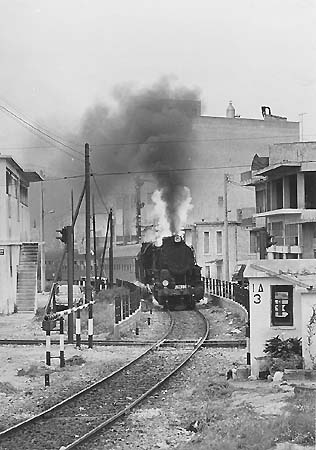
Express Istanbul - Athens shunted by a 2-10-0 type Lambda-gamma, Pireas 1971 (WS)
|
The Orient-Express – that legend during more than a century has spread from the Channel and Paris to the Alps, to Italy, to Czechoslovakia, Poland, Hungary, Romania, to the Balkans, Greece, Turkey. And the photographers hunting that legend under steam were innumerable. In Austria, trains in landscape, including the Orient-Express, were photographed already in the 19th century. In Germany, Carl Bellingrodt was arrested, then becoming German Reichsbahn’s official photographer. Wagon-Lits historian Roger Commault had the honor of being photographed for advertisement, clothed as a conductor. Wilhelm Tausche photographed trains and planes in pre-war Czechoslovakia, and Mikhail Kubinszki did it in Hungary even during WWII. Hans Kundmann photographed expresses until he went blind. Marc Dahlstrom rode his motorbike through Yugoslavia for train photography, of course interrogated. Guenter Haslbeck jumped off the rolling train after he had been arrested somewhere in Tito’s Yugoslavia. The author was not imprisoned when his camera snapped the Moscow train crossing the Bulgarian Danube bridge during Soviet time, for the friendly officers had allowed it. And publishing those photographs was made possible for the author by Alf Teloeken, his first publisher, then also by Rowohlt and by Siegfried Bufe. But photographing an old steam locomotive in a Yugoslav border station, the author was arrested and only the tears of our daughter caused the release. When the well-known Dr. Fritz Stoeckl photographed a Romanian government saloon car, a privileged aboard shouted angrily “diplomatii.” At another time, a conductor warned the author: “A minister is the passenger.” Surely those trips showed Romanian president Ceausescu’s ambitions of demonstrating some independence from the Soviets, an explanation why the Orient-Express did run from Paris to Bucharest until 1991, then only to Budapest, later Vienna. How many wrong other data have been published about this most famous train! Fritz was caught in Thessaloniki when he tried to approach the engine shed. Freedom of movement had our friend Vasilis Leondopoulos, for he was Greek railways’ CEO. And many years before, Sir Peter Allen could photograph the Simplon-Orient-Express in Thrakia on the way to Turkey even during the aftermath of the Greek civil war. Historian George Behrend had almost been killed there at the end of World War II, not by fighting, but by a train passing his military truck. K.R.M. Cameron had no problems when taking photographs during WWII in the Middle East, for he was a General. More hazardous it had been for rail enthusiast Hans Kohut, a Jew fled from Vienna, for he was simply a soldier of the British Army. His friend Ernst Wolf, who almost had been killed by the Nazies, photographed the British Army train to Austria after the war. Nobody knew that on board had worked another friend, a former SS secret service officer, who kept it secret, of course. Also others escaped from being captured. Once the Orient-Express had been diverted via the secondary line Holzkirchen – Rosenheim, Wilhelm Tausche was the only photographer who knew it and his Leica snapped the diverted express, maybe a friend has arranged it. Decades ago, hunting not the Orient-Express, but some steam locomotive at the Austrian-Czech border, somebody was met crossing the rails, who might he be? Guenter Haslbeck, one of the last steam locomotive hunters in China and in South Africa, friend of Dave Wardale, the last and ultimate steam locomotive designer. One of the most renowned photo enthusiasts has been Gottfried Turnwald, our “Turni”, and when he abandoned us in an old age, the locomotive of a train in Czechia sounded its horn for minutes, nobody aboard the train nor anybody in the stations knew why … Only we know: It was exactly the minute when his sarcophagus was buried.
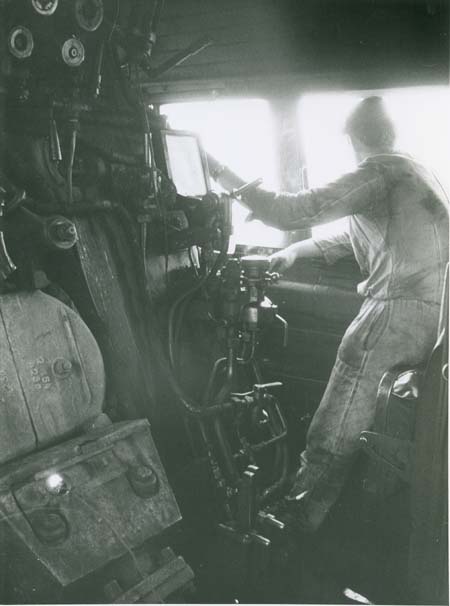
Czech 498.1, driven by Jan Stefanik, hauling the Balt-Orient-Express in 1967 (photo by Tony Hudson)
|
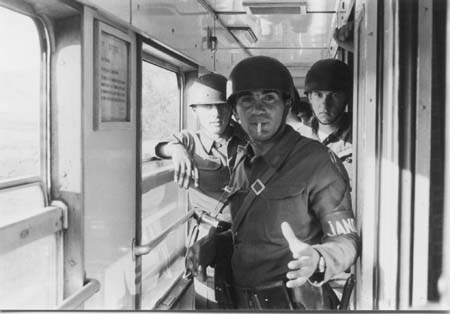
Peaceful meeting in Turkey, 1983 (WS)
|
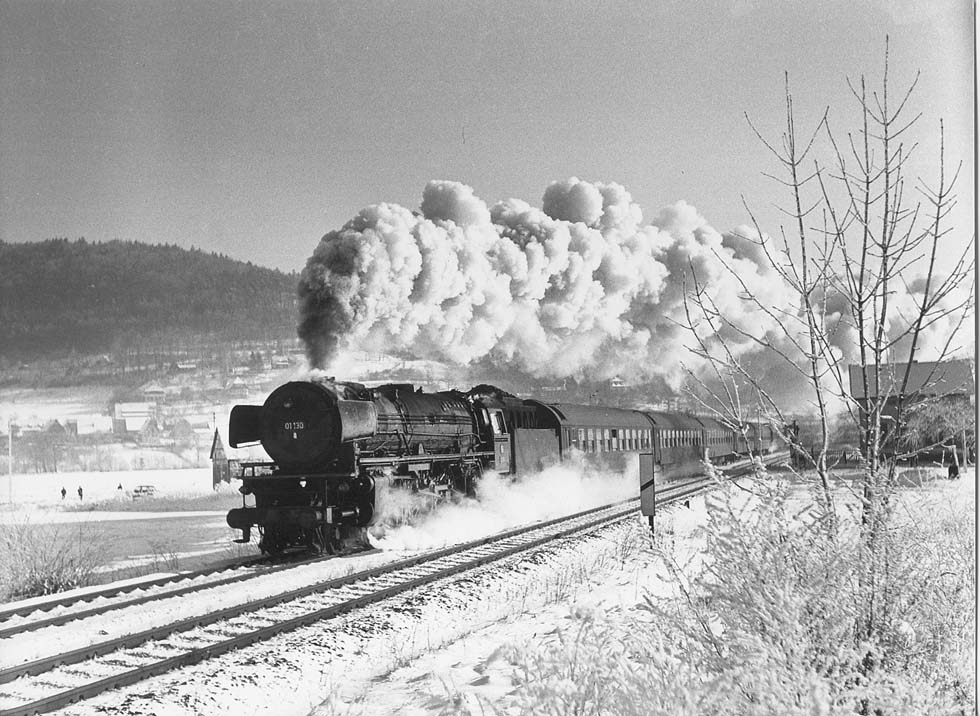
Orient-Express branch Paris – Prague with DB 01 130 near Hersbruck, Jan.1966 (Gottfried Turnwald)
Decades ago, after the funeral of our dear aunt Gis (whose husband had worked at pre-war Austrian state railways), the mourners waited at the small Westbahn station, the Orient-Express was to pass there always without stop, but the station-master stopped it by signal and red flag, not without having asked for permission at Vienna, for the Orient-Express is a “holy” train, he said – “ein heiliger Zug.”
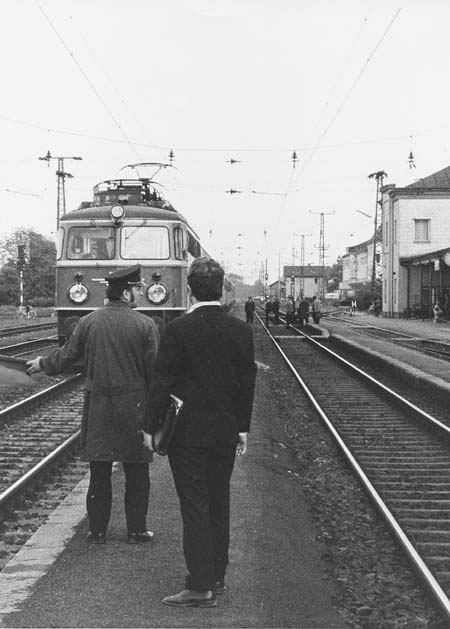 The Orient-Express being stopped for us (photo by Kurt Soelch)
The Orient-Express being stopped for us (photo by Kurt Soelch)
Literature
by the author in German, the only Orient Express books including complete formations, locomotive and CIWL car lists, covering the trains' history of the Southeast of Europe:
Orient-Express, Alba Publikation 1974, 76, 83; rororo Rowohlt, Reinbek 1980 (sold out);
Orient-Express, Alba Publikation 1998 (updated new edition);
Orient-Express im Bild, Bufe-Fachbuch-Verlag, Egglham 1985 (sold out).
The books are placed in the libraries:
Bayerische Staatsbibliothek, Munich.
The British Museum, Central Library, London.
DB-Museum, Nurnberg
Deutsches Museum, Munich
Israel Railway Museum, Haifa
Musée Francais du Chemin de Fer, Mulhouse
Museum für Verkehr und Techik, Berlin
National Railway Museum, York, UK
Wien Museum, Vienna.
The extensive collection of original photographs and documents will be for sale. Pictures for a book about romantic travels in the past are kept by the author (cooperation welcome).
For more information about the various Orient Expresses read
Orient-Express Glanzzeit, Niedergang und Wiedergeburt eines Luxuszuges,
Alba Publikation Alf Teloeken GmbH, Duesseldorf, www.alba-verlag.de
|









 The Orient-Express being stopped for us (photo by Kurt Soelch)
The Orient-Express being stopped for us (photo by Kurt Soelch)


